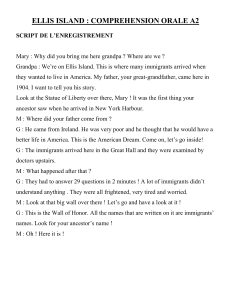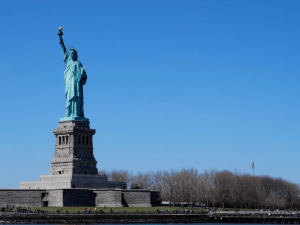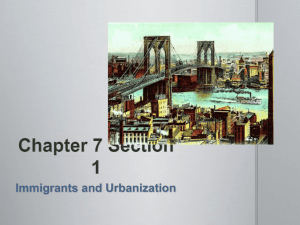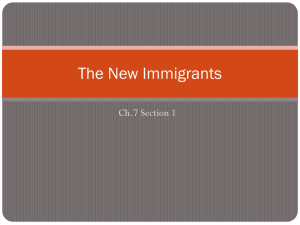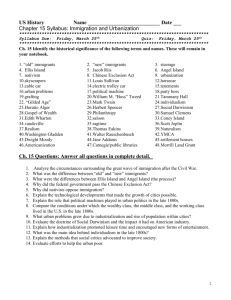New Immigrants
advertisement
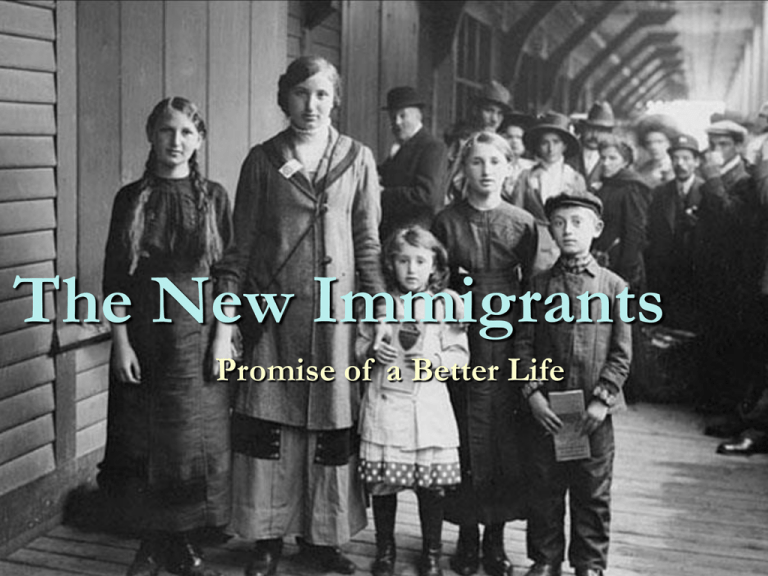
The New Immigrants Promise of a Better Life The New Immigrants • Millions of immigrants entered the U.S. in the late 19th and early 20th centuries. Some came to escape difficult times, others known as “birds of passage” intended to stay only temporarily to earn money and then return to their homeland. Europeans • Between 1870 and 1920, about 20 million Europeans arrived in the United States. Before 1890, most were from western & northern Europe. After 1890, most came from southern & eastern Europe. All were looking for opportunity Chinese • Between 1851 and 1882, about 300,000 Chinese arrived on the West Coast. Some were attracted by the Gold Rush, others went to work for the railroads, farmed, or worked as domestic servants. An antiChinese immigration act passed by Congress curtailed immigration after 1882. Japanese • In 1884, the Japanese government allowed Hawaiian planters to recruit Japanese workers. The U.S. annexation of Hawaii in 1898 increased Japanese immigration to the west coast. By 1920, more than 200,000 Japanese lived on the west coast The West Indies and Mexico • Between 1880 and 1920, about 260,000 immigrants arrived in the United States from the West Indies (Jamaica, Cuba, Puerto Rico, and other islands). Mexicans, too, came to the U.S. to find work and flee political turmoil – 700,000 Mexicans arrived in the early 20th century. Arriving in the New Land • In the late 19th century most immigrants arrived by boat. The trip from Europe took about a month, while it took about three weeks from Asia. The trip was arduous and many died along the way. Destination was Ellis Island for Europeans, and Angel Island for Asians. Ellis Island, New York • From 1892-1924, 17 million European immigrants passed through Ellis Island’s facilities. Processing took hours, and the sick were sent home. Immigrants had to show that they were not criminals, had some money ($25), and were able to work. Ellis Island Angel Island, San Francisco • Asians, primarily Chinese, arriving on the West Coast gained admission at Angel Island in the San Francisco Bay. Processing was much harsher than Ellis Island as immigrants withstood tough questioning and long detentions in filthy conditions. Ethnic Neighborhoods • When immigrants arrived, they were greeted with hostility by some native-born Americans. To preserve their culture and survive in the new land, the newcomers built ethnic neighborhoods (Little Italies, Little Polands, Germantowns, Chinatowns). Some came to think of themselves as hyphenated Americans. MULBERRY ST NYC, 1900 Immigrant Restrictions Anti-Asian feelings included restaurant boycotts • As immigration increased, so did anti-immigrant feelings. Nativism (favoritism toward nativeborn Americans) led to anti-immigrant organizations and restrictions against immigration. In 1882, Congress passed the Chinese Exclusion Act which limited Chinese immigration until 1943.

